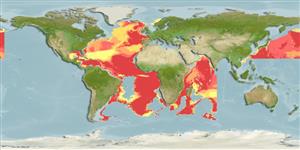Teleostei (teleosts) >
Lophiiformes (Anglerfishes) >
Gigantactinidae (Whipnose anglers)
Etymology: Rhynchactis: Greek, 'rhynch' = beak or snout + Greek, 'aktis' = ray (in reference to the illicium that arises near the tip of the snout) (Ref. 86949); macrothrix: Specific name refers to the relatively long secondary filaments of the illicium.
Environment: milieu / climate zone / depth range / distribution range
Ecology
Marine; bathypelagic; depth range 300 - 2000 m (Ref. 86949). Deep-water
Atlantic and Western Indian Ocean (Ref. 28611). Reported from western Pacific in Taiwan (Ref. 122006).
Size / Weight / Age
Maturity: Lm ? range ? - ? cm
Max length : 15.2 cm SL (female)
Short description
Identification keys | Morphology | Morphometrics
Dorsal soft rays (total): 4; Anal soft rays: 3. Length of illicium 109-144% SL, distal tip bearing 3-4 small unpigmented filaments, some with tiny distal swelling; distal 28-57% illicial length bearing series of 11-20 secondary filaments, five longest filaments measuring 6-15%SL; each secondary filament with 1-2 unpigmented terminal filaments, some with tiny distal swelling; large specimens (110-113 mm) with secondary filaments darkly pigmented to base of terminal filaments, divided on each side by a narrow, well-defined longitudinal transparent band (Ref. 86949).
Life cycle and mating behavior
Maturity | Reproduction | Spawning | Eggs | Fecundity | Larvae
Bertelsen, E. and T.W. Pietsch, 1998. Revision of the deepsea anglerfish genus Rhynchactis Regan (Lophiiformes: Gigantactinidae), with descriptions of two new species. Copeia 1998(3):583-590. (Ref. 28611)
IUCN Red List Status (Ref. 130435: Version 2024-1)
Threat to humans
Harmless
Human uses
Tools
Special reports
Download XML
Internet sources
Estimates based on models
Preferred temperature (Ref.
123201): 2 - 9, mean 6.1 °C (based on 368 cells).
Phylogenetic diversity index (Ref.
82804): PD
50 = 0.6250 [Uniqueness, from 0.5 = low to 2.0 = high].
Bayesian length-weight: a=0.01995 (0.00906 - 0.04395), b=3.01 (2.83 - 3.19), in cm total length, based on all LWR estimates for this body shape (Ref.
93245).
Trophic level (Ref.
69278): 3.9 ±0.7 se; based on size and trophs of closest relatives
Fishing Vulnerability (Ref.
59153): Low vulnerability (10 of 100).
